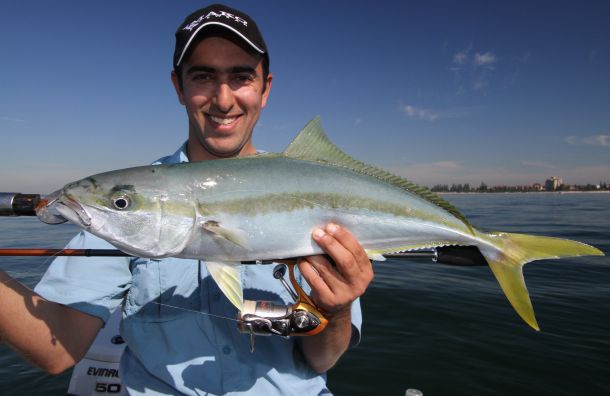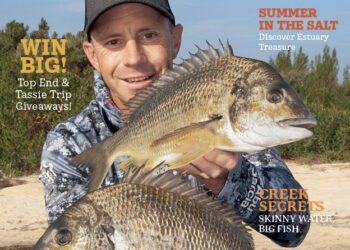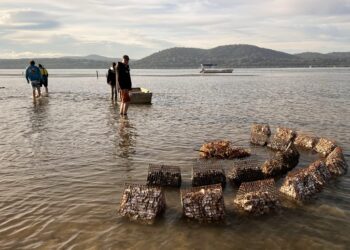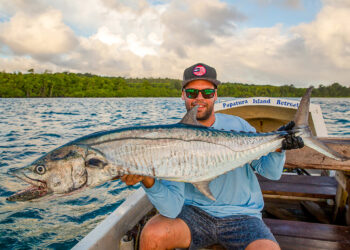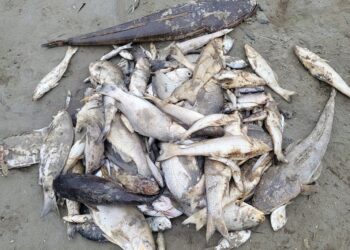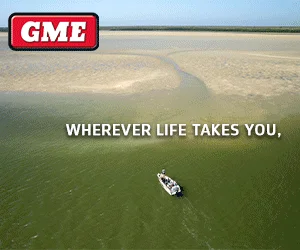BURNING rubber isn’t a smell most fishos probably associate with their favourite pastime, but spend enough time fishing Sydney’s Botany Bay and the distinctive aroma is something your nose gets used to. As well as being the country’s most historic waterway, Botany Bay is also the expanse of water that international and domestic aircraft cross on their way in and out of Sydney. And as the sun rises, airport runway traffic gets busy. The aroma of burning rubber is strong in the air at this time as planes queue to land and take off.
Last Saturday morning saw Fisho’s Sami Omari and me fishing close to runway no.3. It juts well out into the Bay and as a result is a drawcard for many of its fish, especially migrating pelagics like kingfish, salmon, bonito and tailor. With the onset of summer, kingfish arrive in Botany Bay in schools. Many take up residency during these warm water months under perimeter markers that sit off the airport’s runways. These mark the no-go zone for fishing boats. Finding the markers that hold fish can take some prospecting, especially if you haven’t fished the Bay in months, as was the case with Sami and I. Hoping to find surface action on kings in the middle of May was pushing it a bit, which did prove the case as several casts at different markers with a Tango Dancer failing to produce any pelagic interest.
It wasn’t long after 6am and it was very cool – beanie and polar fleece jackets type cool. A light wind blew in from the west as we looked for respite inside one of the runway’s adjoining bays. A few hours later we’d be shedding clothing layers as the temperature would hit 25 degrees.
Sami spotted a couple of diving birds and kept a watch in case there was some surface action in the offing. I watched the sounder as we worked our way along the inner markings. The Raymarine screen’s bottom half was suddenly littered with unmistakable arched readings, and plenty of them. I dropped a 3/8oz jighead loaded with a Squidgy Flickbait down to the bottom. A few lift and drops with the rod and it loaded up. A strong fish powered away and angled up to the surface, revealing itself with a splashy leap. A chunky Aussie salmon, it soon managed to fling the soft plastic in the other direction. Despite plenty more fish showing on the sounder, the salmon must have alerted its mates as they clearly didn’t want to play, despite our best efforts.

An average sized Botany Bay trevally.
We plied the inside of the runway with small soft plastics for the next hour or so, for moderate results. A few just legal, or under, flatties ate our Gulp Grubs or Squidgy Stealth Prawns as did a few pinkie snapper and silver trevally. Sami was getting restless at the lack of action and was keen for a move. He’d fished the upper Sydney Harbour the previous afternoon and scored some huge tailor (to 63cm) on soft plastics, so may have been feeling non-plussed about driving all the way south to fish Botany Bay for the as yet not overly inspiring fishing. The old “don’t leave fish to find fish” saying may have yet been proven true again…

One of Sami’s tailor from the upper Sydney Harbour caught the day before.
Sami suggested we point the Webster west and concentrate our efforts closer to shore over some sand flats, close to a drop-off. On the first hour of the making tide it proved the right call. As we started our drift over the flats I stayed with one of my favourite little soft plastics, the Squidgy Steath Prawn. Virtually from the first cast it accounted for a procession of average winter-sized silver trevally, and a reasonable bream.

The bite looked very promising, although grabbing a camera in the middle of it proved not such a great option. I suggested getting some photos of the trevs for this report. While a just landed fish swam in the Environet I readied the camera ready for Sami. We then messed around getting the boat at the right angle to the sun, and moving gear off the clutterd deck. Eventually I fished the trev out of the environet.
“Ready?” I asked.
“Yep.”
I held the trev up, it squirmed and leapt from my grasp, back into the water. Luckily it was still connected to the lure. I handlined it in, the lure pulled out. The trevally swam away. The resulting pic is nearby…

Idiot…
Luckily the fish were patient and still waiting for our lures. Sami was soon hooking and landing average sized trevally on his favourite Gulp Grub.
Silver trevally or “blurters” are a great fish and always give a great account of themselves. These ones were obviously very hungry, with many hookups occurring on the drop just after our plastics hit the water.

A few flatties were on the chew, including this beauty and below.
Sami also landed several flatties, including a nice 50cm plus model. For some reason my lure only found the younger generation of lizards and I couldn’t crack it for a legal-sized fish. As the temperature began to climb the bite ramped up with us enjoying virtually a fish a cast for a period there. Sami’s next hookup initially looked like that of the 1.5-2kg trevally he’s previously caught in the Bay. The fish made a strong screaming run after hookup, but after going on with it we started to wonder. With no signature trevally tail beats transmitted up the line and an erratic fight pattern we started to think he’d hooked a king. Sure enough, after circling the boat completely the unmistakable yellowtail of a king could be seen as it dived under the boat. Some patient rod work with the light gear saw Sami eventually lead it to the net. The king measured exactly 60cm on the ruler and after it behaved for a few pics, we put it back into the water and it took off like a shot.
If the day was a sign of what’s in store for fishos at Botany Bay over the winter months, braving chilly mornings will be well worth the effort. Here’s hoping.






